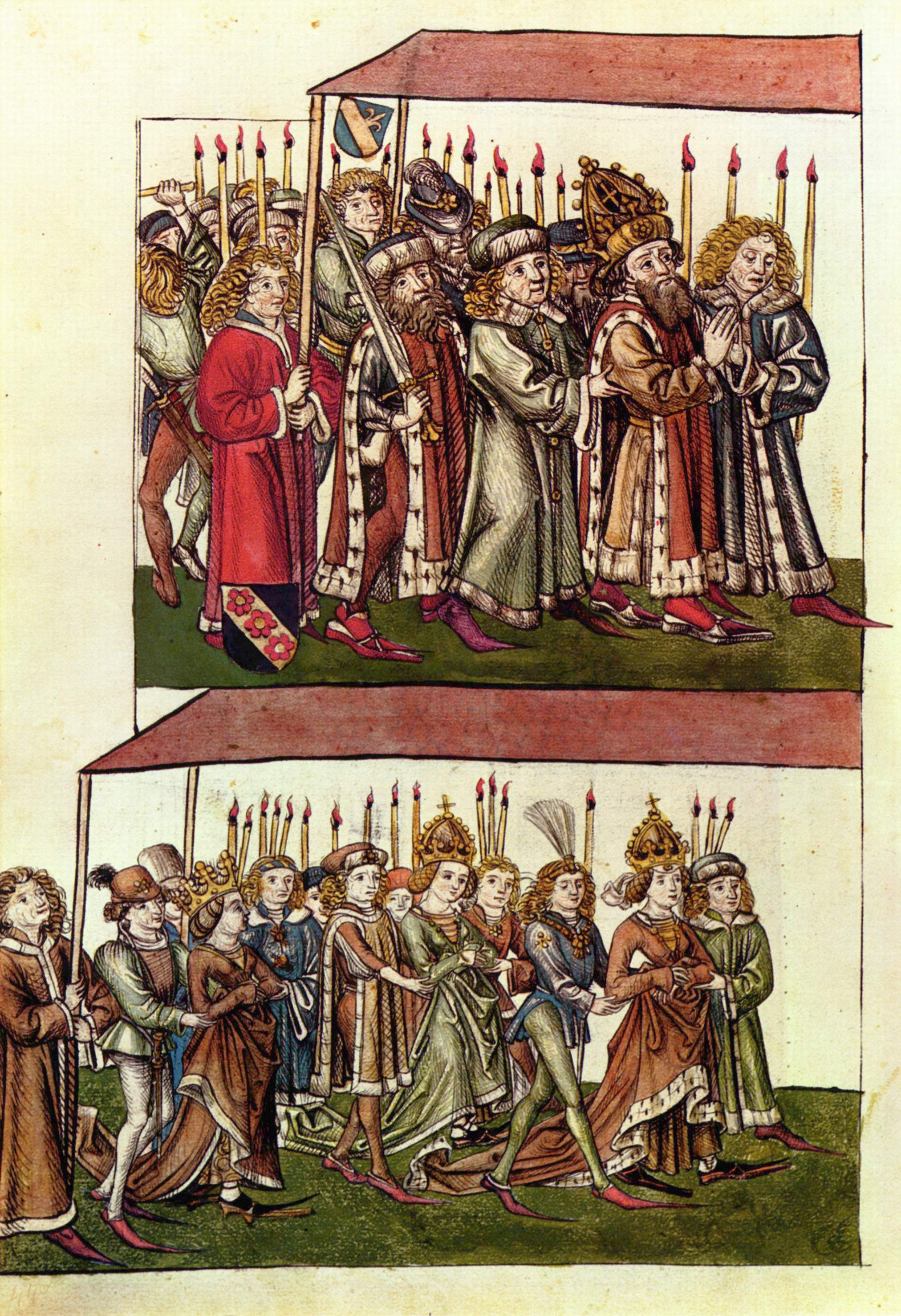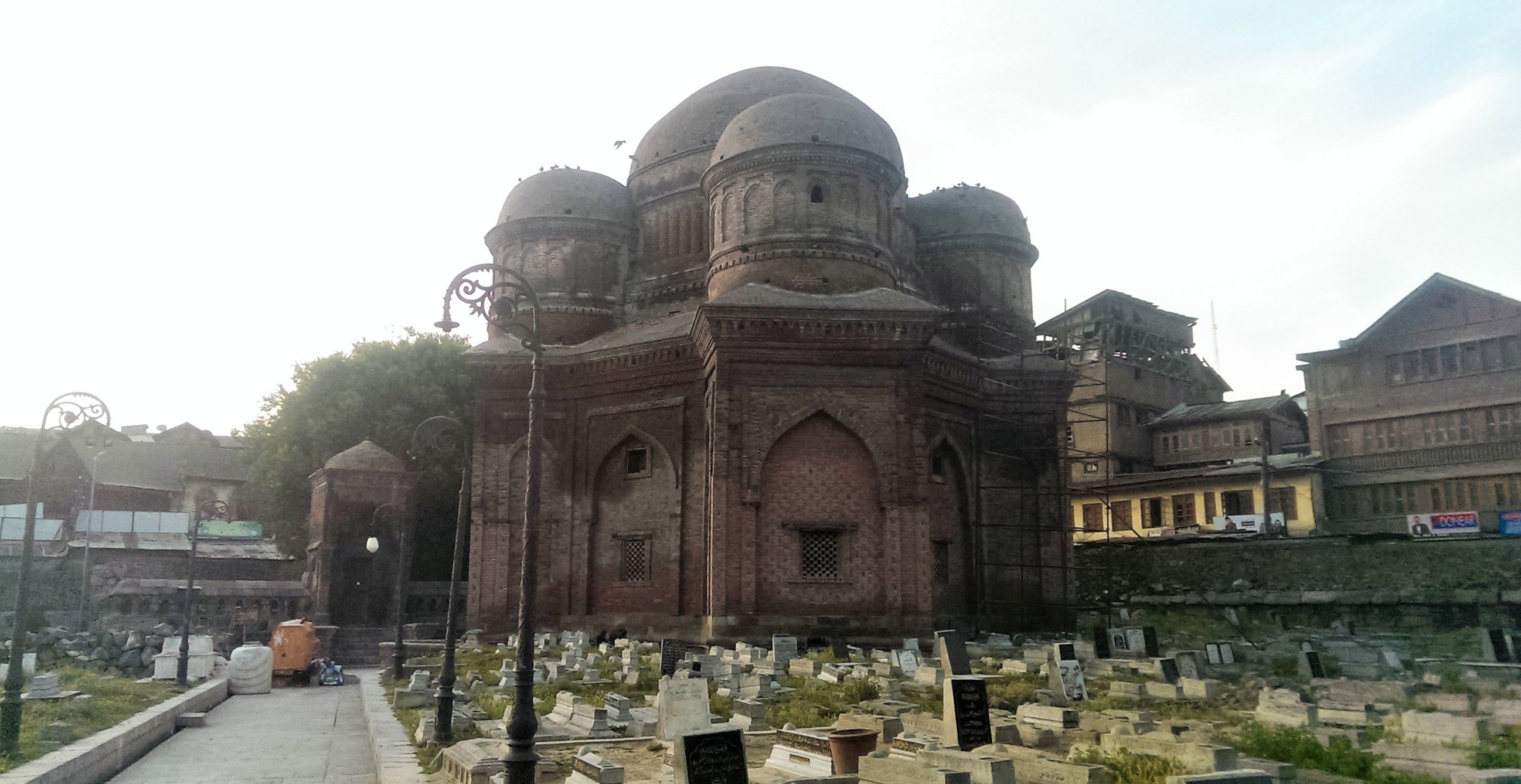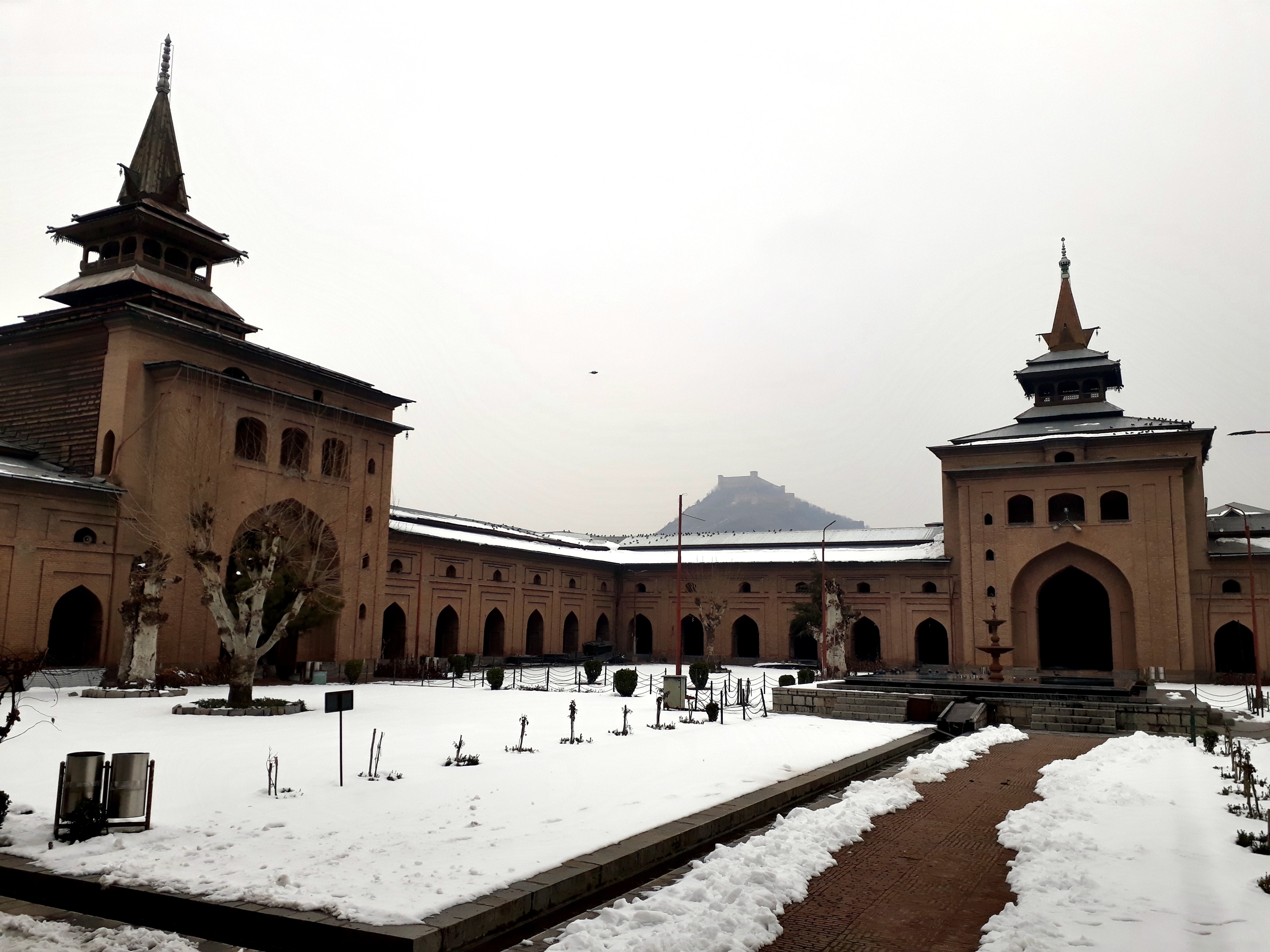|
1418
Year 1418 ( MCDXVIII) was a common year starting on Saturday of the Julian calendar. Events January–March * January 31 – Mircea I, Prince of Wallachia (now part of southern Romania), dies after a reign of 21 years and is succeeded by his son, Mihail I. * February 7 – The Lam S∆°n uprising in Chinese-occupied Vietnam beginsduring the T·∫øt holiday as a group of 18 men led by L√™ L·ª£i begin a nine year rebellion against Ming dynasty China. * February 20 – At Srinagar, in what is now India, Zayn al-Abidin, already the vizier (Wazir) of the Kashmir Sultanate, is crowned as the new Sultan after he overthrows his older brother, the Sultan Ali Shah Miri. * March 21 – The Concordats of Constance are approved by the Council of Constance for signing by the various parties.Mandell Creighton, ''A History of the Papacy during the Period of the Reformation, Vol. I: The Great Schism‚ÄîThe Council of Constance, 1378‚Äì1418'' (Boston: Houghton, Mifflin ... [...More Info...] [...Related Items...] OR: [Wikipedia] [Google] [Baidu] |
Mircea I Of Wallachia
Mircea the Elder (, ; 1355 – 31 January 1418) was the Voivode of Wallachia from 1386 until his death in 1418. He was the son of Radu I of Wallachia and brother of Dan I of Wallachia, after whose death he inherited the throne. After the death of his step-brother Dan I, Mircea takes over the throne in 1386, as Wallachia, on one side, was going through a process of economic, administrative, religious development, but also of strengthening the army, and on the other side it was confronted with the expansion tendencies of the Hungarian Kingdom and Poland, which were aiming at controlling the mouths of the Danube, but also those of the Ottoman Empire in the Balkans. During the reign of Mircea the Elder, Wallachia controlled the largest area in its history, gaining Dobruja in 1388, the Banate of Severin in 1388/9 and Podunavia (which is suspected to be the Timok Valley, or the name of the Danube river valley in Slavonic as stated in Mircea's letter ''"both sides of Danube"''). ... [...More Info...] [...Related Items...] OR: [Wikipedia] [Google] [Baidu] |
Council Of Constance
The Council of Constance (; ) was an ecumenical council of the Catholic Church that was held from 1414 to 1418 in the Bishopric of Constance (Konstanz) in present-day Germany. This was the first time that an ecumenical council was convened in the Holy Roman Empire. The council ended the Western Schism by deposing or accepting the resignation of the remaining papal claimants and by electing Pope Martin V. It was the last papal election to take place outside of Italy. The council also condemned Jan Hus as a heretic and facilitated his execution; and it ruled on issues of national sovereignty and the rights of pagans and just war in response to a conflict between the Grand Duchy of Lithuania, the Kingdom of Poland and the Order of the Teutonic Knights. The council is also important for its role in the debates over ecclesial conciliarism and papal supremacy. Constance issued two particularly significant decrees regarding the constitution of the Catholic Church: '' Haec sancta'' ... [...More Info...] [...Related Items...] OR: [Wikipedia] [Google] [Baidu] |
Concordats Of Constance
The Concordats of Constance were five agreements between the Catholic Church and the "nations" of England (including Scotland), France, Germany (including Scandinavia and eastern Europe), Italy ( Imperial Italy, the Papal States, Naples, Sicily, and the Venetian Republic) and Spain (Aragon, Castile, Navarre and Portugal) in the aftermath of the Council of Constance (1414–18) that ended the Western Schism. The French and German concordats were signed on 15 April 1418, the Spanish on 13 May and the English on 12 July. The Italian agreement is lost. The delegates to the council had sat as five nations—England, France, Germany, Italy and Spain—each with one vote. On 21 March 1418, the concordats were approved in advance by the council as conforming to and fulfilling the decrees of 30 October 1417.Mandell Creighton, ''A History of the Papcy during the Period of the Reformation, Vol. I: The Great Schism—The Council of Constance, 1378–1418'' (Boston: Houghton, Mifflin & Co., 1882 ... [...More Info...] [...Related Items...] OR: [Wikipedia] [Google] [Baidu] |
Lê Lợi
Lê Lợi (, chữ Hán: 黎利; 10 September 1385 – 5 October 1433), also known by his temple name as Lê Thái Tổ (黎太祖) and by his pre-imperial title Bình Định vương (平定王; "Prince of Pacification"), was a Vietnamese people, Vietnamese rebel leader who founded the Lê dynasty, Later Lê dynasty and became the first king of the restored kingdom of Đại Việt after the country was Ming conquest of Đại Việt, conquered by the Ming dynasty. In 1418, Lê Lợi and his followers Lam Sơn Uprising, rose up against Fourth Era of Northern Domination, Ming rule. He was known for his effective guerrilla tactics, including constantly moving his camps and using small bands of irregulars to ambush the larger Ming forces. Nine years later, his resistance movement successfully drove the Ming armies out of Vietnam and restored Vietnamese independence. Lê Lợi is among the most famous figures of Vietnamese history and one of its greatest heroes. Background From the ... [...More Info...] [...Related Items...] OR: [Wikipedia] [Google] [Baidu] |
Michael I Of Wallachia
Michael I (), (? – August 1420) was Voivode of Wallachia from 1415 to 1420. He was the only legitimate son of Mircea I of Wallachia, who made him his co-ruler. Styled as prince from 1415, Michael became sole ruler after his father died in early 1418. His support for a Hungarian campaign against the Ottoman Empire caused the Ottoman Sultan, Mehmed I, to invade Wallachia, forcing him to agree to pay tribute. After Michael failed to respect the treaty, the Ottomans gave assistance to his rival, Dan, who crossed into Wallachia in 1420. Dan and his Ottoman allies defeated the Wallachian army, and Michael was killed on the battlefield. Early life The son of Mircea I of Wallachia and his wife, Maria Tolmay, Michael was Mircea's only legitimate son. Alexander Aldea and Vlad were Michael's most prominent illegitimate half-brothers, who, in accordance with local custom, could have claimed the throne of Wallachia. To strengthen Michael's position, his father made him his co-ruler. ... [...More Info...] [...Related Items...] OR: [Wikipedia] [Google] [Baidu] |
Zayn Al-Abidin The Great
Ghiyath al-Din Shah Rukh Shahi Khan (; 25 November 1395 – 5 April 1470), commonly known as Zayn al-Abidin the Great, was the ninth sultan of the Kashmir Sultanate, ruling first from 1418 to 1419 and then from 1420 to 1470. He was famously called Budshah (Great King) by his subjects. The first 35 years of his reign are described by Jonaraja in the ''Rajatarangini Dvitiya'', while the subsequent years are described by his pupil, Shrivara, Srivara, in the ''Rajatarangini Tritiya''. The Sultan also composed poetry in Persian under the pen name of Qutb. Under Zayn al-Abidin’s five-decade rule, Kashmir flourished with a remarkable economic stability, which spurred significant commercial growth. Diplomatic missions were dispatched to foreign lands, enhancing trade networks and boosting the region's commercial standing. This led to the expansion of bustling central markets in Srinagar and Anantnag. His reign also witnessed a vibrant Culture of Kashmir, cultural renaissance, with a ... [...More Info...] [...Related Items...] OR: [Wikipedia] [Google] [Baidu] |
Ali Shah Miri
Ali Shah Miri ( Kashmiri and ) also known as Ali Shah () was eighth Sultan of Kashmir from 1413 to 1418 and then again from 1419 to 1420. Ali Shah belonged to the Shah Mir dynasty and was succeeded by his younger brother Zain-ul-Abidin. Reign After Sikandar's death, his eldest son ''Mir'' succeeded him as the Sultan, having adopted the title of Ali Shah. Ali Shah became the seventh sultan of the Shah Mir dynasty, and reigned between 1413 and 1420. His reign was peaceful. Under Ali Shah's regime, Suhabhatta became the Prime Minister. Ali Shah was defeated by Sultan Zain-ul-Abidin at Thanna with the help of Jasrath Khokhar, a chieftain from Pothohar Plateau. The fate of Ali Shah is uncertain: he may have died in captivity or have been put to death by Khokhar. Dethronement Shahi Khan, a son of Sultan Sikander the ruler of Kashmir, was charged with the rule of the kingdom of Kashmir when his elder brother, Ali Shah, left the kingdom on a pilgrimage to Mecca. It was at th ... [...More Info...] [...Related Items...] OR: [Wikipedia] [Google] [Baidu] |
February 7
Events Pre-1600 * 457 РLeo I becomes the Eastern Roman emperor. * 987 РBardas Phokas the Younger and Bardas Skleros, Byzantine generals of the military elite, begin a wide-scale rebellion against Emperor Basil II. * 1301 РEdward of Caernarvon (later King Edward II of England) becomes the first English Prince of Wales. * 1313 РKing Thihathu founds the Pinya Kingdom as the de jure successor state of the Pagan Kingdom. * 1365 РAlbert III of Mecklenburg (King Albert of Sweden) grants city rights to Ulvila (). * 1497 РIn Florence, Italy, supporters of Girolamo Savonarola burn cosmetics, art, and books, in a " Bonfire of the vanities". 1601–1900 * 1756 РGuaraní War: The leader of the Guaraní rebels, Sepé Tiaraju, is killed in a skirmish with Spanish and Portuguese troops. * 1783 РAmerican Revolutionary War: French and Spanish forces lift the Great Siege of Gibraltar. * 1795 РThe 11th Amendment ... [...More Info...] [...Related Items...] OR: [Wikipedia] [Google] [Baidu] |
List Of Princes Of Wallachia
This is a list of princes of Wallachia, from the first mention of a medieval polity situated between the Southern Carpathians and the Danube until the union with Moldavia in 1859, which unification of Moldavia and Wallachia, led to the creation of Romania. Notes Dynastic rule is hard to ascribe, given the loose traditional definition of the ruling family. On principle, princes were chosen from any family branch, including a previous ruler's bastard sons, being defined as ''os de domn'', "of Voivode marrow", or as having ''heregie'', "heredity" (from the Latin ''hereditas''); the institutions charged with the Elective monarchy, election, dominated by the boyars, had fluctuating degrees of influence. The system itself was challenged by usurpers, and became obsolete with the Phanariotes, Phanariote epoch, when rulers were appointed by the Ottoman Empire, Ottoman Sultans; between 1821 and 1878 (the date of Romania's independence), various systems combining election and appointment were ... [...More Info...] [...Related Items...] OR: [Wikipedia] [Google] [Baidu] |
Kashmir Sultanate
The Kashmir Sultanate, historically Latinised as the Sultanate of Cashmere and officially known as the State of Kashmir, was a Medieval India, medieval kingdom established in the early 14th century, primarily in the Kashmir Valley, found in the northern part of the Indian subcontinent. The Sultanate was founded by Rinchan, Rinchan Shah, a Ladakhis, Ladakhi noble who converted from Buddhism to Islam. The Sultanate was briefly interrupted by the Lohara dynasty, Loharas until Shah Mir, a councillor of Rinchan, Shah Mir–Lohara War, overthrew the Loharas and started his Shah Mir dynasty, own dynasty. The Shah Mirs ruled from 1339 until they were deposed by the Chak dynasty, Chak warlords and nobles in 1561. The Chaks continued to rule the Sultanate until the Mughal conquest of Kashmir, Mughal conquest in 1586 and their surrender in 1589. The Kashmir Sultanate was a Muslim monarchy comprising Kashmiris, Kashmiri, Turco-Persian tradition, Turco–Persian, Indus Kohistani people, Kohi ... [...More Info...] [...Related Items...] OR: [Wikipedia] [Google] [Baidu] |
John The Fearless
John I (; ; 28 May 1371 – 10 September 1419) was a scion of the French royal family who ruled the Burgundian State from 1404 until his assassination in 1419. He played a key role in French national affairs during the early 15th century, particularly in his struggle to remove the mentally ill King Charles VI and during the Hundred Years' War against the Kingdom of England. A rash, ruthless and unscrupulous politician, John murdered Charles's brother, the Duke of Orléans, in an attempt to gain control of the government, which led to the eruption of the Armagnac–Burgundian Civil War in France and in turn culminated in his own assassination in 1419. The involvement of Charles, the heir to the French throne, in his assassination prompted John's son and successor Philip to seek an alliance with the English, thereby bringing the Hundred Years' War to its final phase. John, like his father Philip before him, played an important role in the development of gunpowder artiller ... [...More Info...] [...Related Items...] OR: [Wikipedia] [Google] [Baidu] |
Švitrigaila
Švitrigaila (before 1370 – 10 February 1452; sometimes spelled Svidrigiello) was the Grand Duke of Lithuania from 1430 to 1432. He spent most of his life in largely unsuccessful dynastic struggles against his cousins Vytautas and Sigismund Kęstutaitis. Early life and Vitebsk rebellion Švitrigaila was born to Algirdas, Grand Duke of Lithuania, and his second wife Uliana of Tver. His date of birth is unknown, but it is believed that he was the youngest or second youngest son of Algirdas. He first appeared in politics in October 1382 when he witnessed the Treaty of Dubysa between his elder brother Jogaila and the Teutonic Knights. Historians believe that would indicate that at the time Švitrigaila was no younger than 12 which would put his date of birth sometime before 1370. In a complaint submitted to the Council of Florence, Švitrigaila claimed that he and Jogaila were favorite sons of Algirdas. Before his death in 1377, Algirdas transferred his throne to Jogaila but made h ... [...More Info...] [...Related Items...] OR: [Wikipedia] [Google] [Baidu] |







